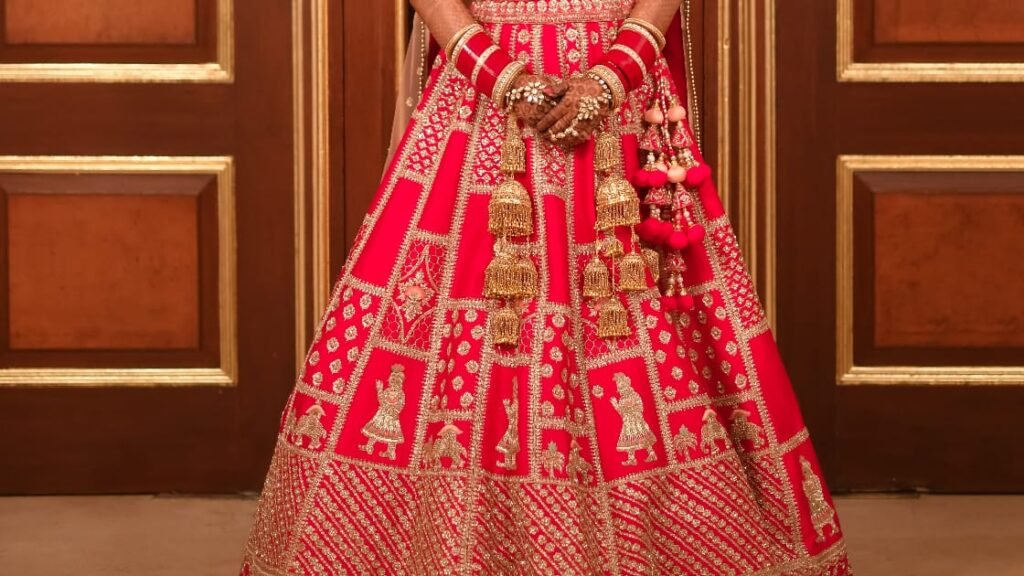Indian weddings are extremely lavish and emotional occasions; if there is any item of clothing that encompasses both of these elements in absolutely the best way, it is undoubtedly the lehenga. The lehenga is not just a piece of cloth, but a statement of tradition, style, culture and even an individual’s character who wear this truly significant garment. Whether it is red classic lehenga or modern-day pastel lehenga, lehenga has significant place and time in a bride’s wedding experience.
Table of Contents
What is the History of the Bridal Lehenga?
Lehenga originated during Mughal times, when royal women generally wore three piece heavily embroidered attire. The ensemble was a long skirt (lehenga), fitted blouse (choli) and a scarf or veil (dupatta). The outfit evolved culturally through centuries that included variations in local styles and colors, materials and modes of embroidery and over time became an essential component of bridal attire, much of which can be found in bridal fashions in most parts of India.
Importance of Bridal Lehenga
Indeed, weddings are huge events in life, and the bride’s outfit determines the overall theme and mood of the celebration. Well, the bridal lehenga as under:
Symbolizes Ethnic Identity: Each region of India has its particular embodiment attached to the lehenga through the use of local fabrics and embroidery styles.
Signifies Heritage: Wearing a lehenga sometimes means being loyal to one’s ancestry.
Represents Individual Style: The lehenga does provide an entire exposition of the bride who may be one minimalist at one time or severely embellished at the next.
Boosts Self-Esteem: A well-fitting, well-cut lehenga will assure that no bride stops acting like royalty.
Getting your bridal lehenga right
Choosing that excellent bridal lehenga is quite something already. It involves thought. Things to think about by brides before finalizing their purchase now include:
1. Color
Red is the most famous traditional color of love and fortune, as well as new beginnings. Nowadays, fresh brides are craving brighter ways of red, such as:
Pastels – peach, baby pink, mint green
Deep colors: royal blue, maroon in depth, emerald green
And Neutral tones: champagne, ivory, gold
Depend on the wedding theme, the bride’s skin complexion, and preference.
2. Fabric
Different fabrics create different looks and comfort levels. Popular options include:
- Silk – Traditional and regal
- Velvet – Rich texture for winter weddings
- Net and Georgette – Lightweight and flowy
- Organza and Tulle – Soft, fairy-tale feel
Brides should choose a fabric that aligns with the weather, comfort, and desired silhouette.
3. Embroidery and Embellishments
The intricacy of the embroidery often defines the elegance of the lehenga. Some popular types are:
- Zari Work – Gold or silver thread embroidery
- Zardozi – Metallic thread, beads, and sequins
- Mirror Work – Reflective embellishments
- Gotapatti – Rajasthani style with gold ribbons
- Stone and Pearl Work – Glamorous and eye-catching
The embellishment style should complement the bride’s taste and the wedding’s grandeur.
4. Silhouette
Lehenga silhouettes profoundly impact the overall look. The most common types are:
- A-line – Form-flared from the waist, which fits most body shapes.
- Fish-cut/Mermaid – Form-fitted to the knees, it is dramatic and modern.Panelled – Several fabric panels can create a flare.
- Circular – Full volume and more traditional.It is best to try all to see which one speaks to you.Custom vs. Off the Rack lehenga
Most brides deliberated between one of a kind custom bridal lehenga or off the rack.
A Custom-Made Bridal Lehenga
Pros:
– One of a kind design that suits your style
– Perfect fit
– Have an input on design
Cons:
– Takes time
– More expensive
– Multiple fittings
Ready-to-Wear Bridal Lehengas
Pros:
– Quicker purchase time
– Generally cheaper
– Variety found in stores
Cons:
– May not fit and may require alterations
– Less personalized
Bridal Lehenga Trends in 2025
The bridal fashion industry has always been an ever-spinning wheel of direction, and with 2025, some new and exciting trends have been emerging in lehengas:
Sustainable lehenga- Eco-friendly fabrics and recycled materials are trending.
Convertible lehenga- A lehenga that converts into a gown or lighter dress for a post-wedding event
.Digital embroidery- Patterns designed and embroidered with a digital machine.
Cape Dupattas– A modern approach to traditional dupattas.
Minimalistic appeal– Simple classy lehengas with less embellishment but luxurious fabrics!
Bridal Lehenga Preservation
Many brides consider preserving their lehenga for sentimental reasons or future wear.
Preservation Tips:
- Dry clean, immediately: Stains, dirt, and oils should be removed.
- Store in muslin: Laying the dress out in a muslin cloth will protect the fabric.
- Avoid putting it on hangers: Fold neatly so as not to stretch out the fabric.
- Storage in cool, dry conditions: Away from sunlight and moisture.
Some brides may opt for the repurposing of their lehenga into a lighter outfit or pass it off as a family heirloom.
Budgeting for a Bridal Lehenga
Depending on designer, fabric, and craftsmanship, a bridal lehenga can cost anywhere from hundreds to thousands of dollars.
- Staying Within Budget:
- Set a price limit
- Look for local designers or boutiques
- Consider renting for one-time use
- Shop off-season sales
- Besides, it is not so much the price as how you feel wearing it that matters.
Final Thoughts
A bridal lehenga is much more than just an attire for a wedding; it is a memory of a lifetime, a symbol of culture, and a personal expression of one’s style. Whether you envision walking down the aisle in a red classic lehenga or one in modern pastels, it is truly paramount that the outfit reflects your personality.


